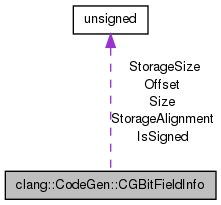Structure with information about how a bitfield should be accessed. More...
#include <CGRecordLayout.h>

Public Member Functions | |
| CGBitFieldInfo () | |
| CGBitFieldInfo (unsigned Offset, unsigned Size, bool IsSigned, unsigned StorageSize, unsigned StorageAlignment) | |
| void | print (raw_ostream &OS) const |
| void | dump () const |
Static Public Member Functions | |
| static CGBitFieldInfo | MakeInfo (class CodeGenTypes &Types, const FieldDecl *FD, uint64_t Offset, uint64_t Size, uint64_t StorageSize, uint64_t StorageAlignment) |
| Given a bit-field decl, build an appropriate helper object for accessing that field (which is expected to have the given offset and size). | |
Public Attributes | |
| unsigned | Offset: 16 |
| unsigned | Size: 15 |
| The total size of the bit-field, in bits. | |
| unsigned | IsSigned: 1 |
| Whether the bit-field is signed. | |
| unsigned | StorageSize |
| unsigned | StorageAlignment |
| The alignment which should be used when accessing the bitfield. | |
Detailed Description
Structure with information about how a bitfield should be accessed.
Often we layout a sequence of bitfields as a contiguous sequence of bits. When the AST record layout does this, we represent it in the LLVM IR's type as either a sequence of i8 members or a byte array to reserve the number of bytes touched without forcing any particular alignment beyond the basic character alignment.
Then accessing a particular bitfield involves converting this byte array into a single integer of that size (i24 or i40 -- may not be power-of-two size), loading it, and shifting and masking to extract the particular subsequence of bits which make up that particular bitfield. This structure encodes the information used to construct the extraction code sequences. The CGRecordLayout also has a field index which encodes which byte-sequence this bitfield falls within. Let's assume the following C struct:
struct S { char a, b, c; unsigned bits : 3; unsigned more_bits : 4; unsigned still_more_bits : 7; };
This will end up as the following LLVM type. The first array is the bitfield, and the second is the padding out to a 4-byte alignmnet.
t = type { i8, i8, i8, i8, i8, [3 x i8] }
When generating code to access more_bits, we'll generate something essentially like this:
define i32 (t* base) { %0 = gep t* base, i32 0, i32 3 %2 = load i8* %1 %3 = lshr i8 %2, 3 %4 = and i8 %3, 15 %5 = zext i8 %4 to i32 ret i32 i }
Definition at line 66 of file CGRecordLayout.h.
Constructor & Destructor Documentation
| clang::CodeGen::CGBitFieldInfo::CGBitFieldInfo | ( | ) | [inline] |
Definition at line 84 of file CGRecordLayout.h.
| clang::CodeGen::CGBitFieldInfo::CGBitFieldInfo | ( | unsigned | Offset, |
| unsigned | Size, | ||
| bool | IsSigned, | ||
| unsigned | StorageSize, | ||
| unsigned | StorageAlignment | ||
| ) | [inline] |
Definition at line 87 of file CGRecordLayout.h.
Member Function Documentation
| void CGBitFieldInfo::dump | ( | ) | const |
Definition at line 842 of file CGRecordLayoutBuilder.cpp.
| CGBitFieldInfo CGBitFieldInfo::MakeInfo | ( | class CodeGenTypes & | Types, |
| const FieldDecl * | FD, | ||
| uint64_t | Offset, | ||
| uint64_t | Size, | ||
| uint64_t | StorageSize, | ||
| uint64_t | StorageAlignment | ||
| ) | [static] |
Given a bit-field decl, build an appropriate helper object for accessing that field (which is expected to have the given offset and size).
Definition at line 630 of file CGRecordLayoutBuilder.cpp.
References clang::CodeGen::CodeGenTypes::ConvertTypeForMem(), clang::CharUnits::fromQuantity(), clang::CodeGen::CodeGenTypes::getContext(), clang::CodeGen::CodeGenTypes::getDataLayout(), clang::ValueDecl::getType(), clang::Type::isSignedIntegerOrEnumerationType(), and clang::ASTContext::toBits().
Referenced by clang::CodeGen::CGObjCRuntime::EmitValueForIvarAtOffset().
| void CGBitFieldInfo::print | ( | raw_ostream & | OS | ) | const |
Definition at line 833 of file CGRecordLayoutBuilder.cpp.
Member Data Documentation
Whether the bit-field is signed.
Definition at line 75 of file CGRecordLayout.h.
Referenced by clang::CodeGen::CodeGenFunction::EmitLoadOfBitfieldLValue(), and clang::CodeGen::CodeGenFunction::EmitStoreThroughBitfieldLValue().
The offset within a contiguous run of bitfields that are represented as a single "field" within the LLVM struct type. This offset is in bits.
Definition at line 69 of file CGRecordLayout.h.
Referenced by clang::CodeGen::CodeGenTypes::ComputeRecordLayout(), clang::CodeGen::CodeGenFunction::EmitLoadOfBitfieldLValue(), and clang::CodeGen::CodeGenFunction::EmitStoreThroughBitfieldLValue().
The total size of the bit-field, in bits.
Definition at line 72 of file CGRecordLayout.h.
Referenced by clang::CodeGen::CodeGenTypes::ComputeRecordLayout(), clang::CodeGen::CodeGenFunction::EmitLoadOfBitfieldLValue(), and clang::CodeGen::CodeGenFunction::EmitStoreThroughBitfieldLValue().
The alignment which should be used when accessing the bitfield.
Definition at line 82 of file CGRecordLayout.h.
Referenced by clang::CodeGen::CodeGenFunction::EmitLoadOfBitfieldLValue(), and clang::CodeGen::CodeGenFunction::EmitStoreThroughBitfieldLValue().
The storage size in bits which should be used when accessing this bitfield.
Definition at line 79 of file CGRecordLayout.h.
Referenced by clang::CodeGen::CodeGenTypes::ComputeRecordLayout(), clang::CodeGen::CodeGenFunction::EmitLoadOfBitfieldLValue(), clang::CodeGen::CodeGenFunction::EmitLValueForField(), clang::CodeGen::CodeGenFunction::EmitStoreThroughBitfieldLValue(), and clang::CodeGen::CGObjCRuntime::EmitValueForIvarAtOffset().
The documentation for this struct was generated from the following files: